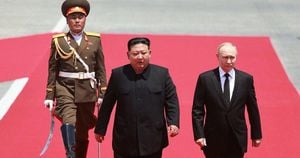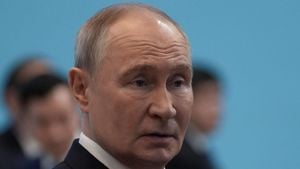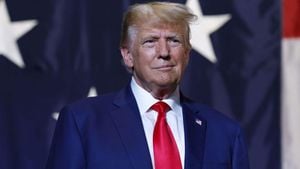With the winds of change swirling across global geopolitics, Russia’s actions on the military front have sent ripples of concern throughout diplomatic circles worldwide. The nation’s renewed focus on nuclear capability, particularly through its offers to India, has raised eyebrows and sparked discussions about the shifting dynamics of power within the Indo-Pacific region. Just recently, reports emerged of Russia extending its proposal to provide India with the advanced Tu-160M 'White Swan' bomber, potentially enhancing India’s long-range military capabilities.
This offer isn’t just about hardware; it’s about strategy. The Tu-160M, which can deliver both conventional and nuclear payloads, is touted as being capable of flying up to 12,000 kilometers without refueling. This powerful aircraft is not only impressive due to its range but also because of the significant upgrade it presents over its predecessor, the original Tu-160. It boasts improved avionics and weaponry, which makes it 60% more effective according to its manufacturer, Tupolev. Each unit can deliver a hefty punch with the capacity to carry 12 long-range cruise missiles.
For India, acquiring the Tu-160M could represent more than just acquisition; it could signify a strategic transition for the Indian Air Force. Traditionally focused on multirole fighters, India might soon find itself reevaluated with the integration of heavy bombers like the Tu-160M, which could bolster its nuclear triad comprising land, sea, and now potentially air capabilities.
But let’s not get too far ahead without acknowledging the steep costs associated with such significant military hardware. The Tu-160M is priced at about USD 163 million per unit, and integrating it within the existing force structure demands adequate infrastructure, specialized training for personnel, and adaptations to airbases. The logistics of maintenance and operational expenses cannot be overlooked either. Essentially, it’s not merely about the acquisition but evaluating whether the strategic advantages align with the extensive financial investments.
Russia's military posturing doesn't stop there. Reports indicate heightened nuclear readiness and military drills reminiscent of Cold War posturing. Russian President Vladimir Putin has consistently emphasized the strength of his country’s nuclear arsenal, creating an environment of uncertainty and tension among other nations. This has beckoned responses from NATO countries and allies who are ever-vigilant of Russia’s military maneuvers.
The backdrop of this military posturing is laden with fears of escalation of conflicts, especially with the situation continuing to evolve around Ukraine. Since the invasion, NATO nations have substantially ramped up their own defenses, inching closer to Russia. With the lines of conflict blurring, the stakes have never been higher.
This brings us to the broader question of nuclear capability globally. Countries are re-assessing their defenses and military strategies as tensions rise. The Biden administration has drawn its own line, issuing stern warnings against any aggressions from Russia. NATO allies have also coordinated to bolster their military presence across Eastern Europe as a protective measure, with the commitment to defend all allies being more resolute than ever.
So, what does the interplay of these developments mean for the future? For one, it signals to nations far and wide the importance of maintaining strategic military readiness. The updates on military hardware, nuclear stockpiling, and advanced defense installations indicate how the modern battlefield may see developments influenced as much by diplomatic cues as by defense strategies.
Just within several weeks, the military has announced major changes to its strategic framework. There’s also been renewed emphasis on collaborative military exercises with partner nations, reinforcing alliances and military readiness aimed at deterring any spikes of aggression. Nations are closely observing the developments, carefully weighing their own responses and preparing contingencies.
While the geopolitical chess game is far from new, the pieces are drastically changing. The latest developments from Russia, particularly concerning its nuclear capabilities, bear close watching not only from India but from nations across many geopolitical spectrums. The intertwining of diplomacy and military maneuvers will undeniably set the stage for conversations on peace, security, and the measures necessary to deter threats arising from war-centric posturing.
Western experts focus on how these military gestures may alter perceptions of strength and vulnerability among allies and adversaries alike. The recurring themes of power, deterrent, and compromise reveal the layered intricacies of international relations—where military capabilities translate directly to leverage on the global stage.
Communication, or lack thereof, remains pivotal to diffusing tensions. It’s not simply about hard power but also about soft power and dialogue—a fact continuously emphasized by defense analysts. Encouraging channels of communication between nuclear powers might be the best way forward, potentially averting conflicts before they escalate.
Through the lens of global security matters, it’s clear: Russia's renewed interest in military cooperation, particularly the offer to India of the Tu-160M bomber, projects its intentions and capacity for defense maneuvers. It has punctuated the framework of strategic interactions, intensifying scrutiny of how other nations will adapt to this rapidly changing situation.
Navigators of international diplomacy must carefully chart their course. With nuclear capabilities at the forefront, the margin for error shrinks, and every decision bears significant weight on global security.
For now, all eyes remain on Russia, India, and their shifting military partnerships, indicative of larger trends playing out on the global stage as nations position themselves for what may come next. With each passing day, the stakes climb higher; the question isn’t merely about who owns what assets but how effectively they manage, secure, and engage these assets within the broader geopolitical arena.



